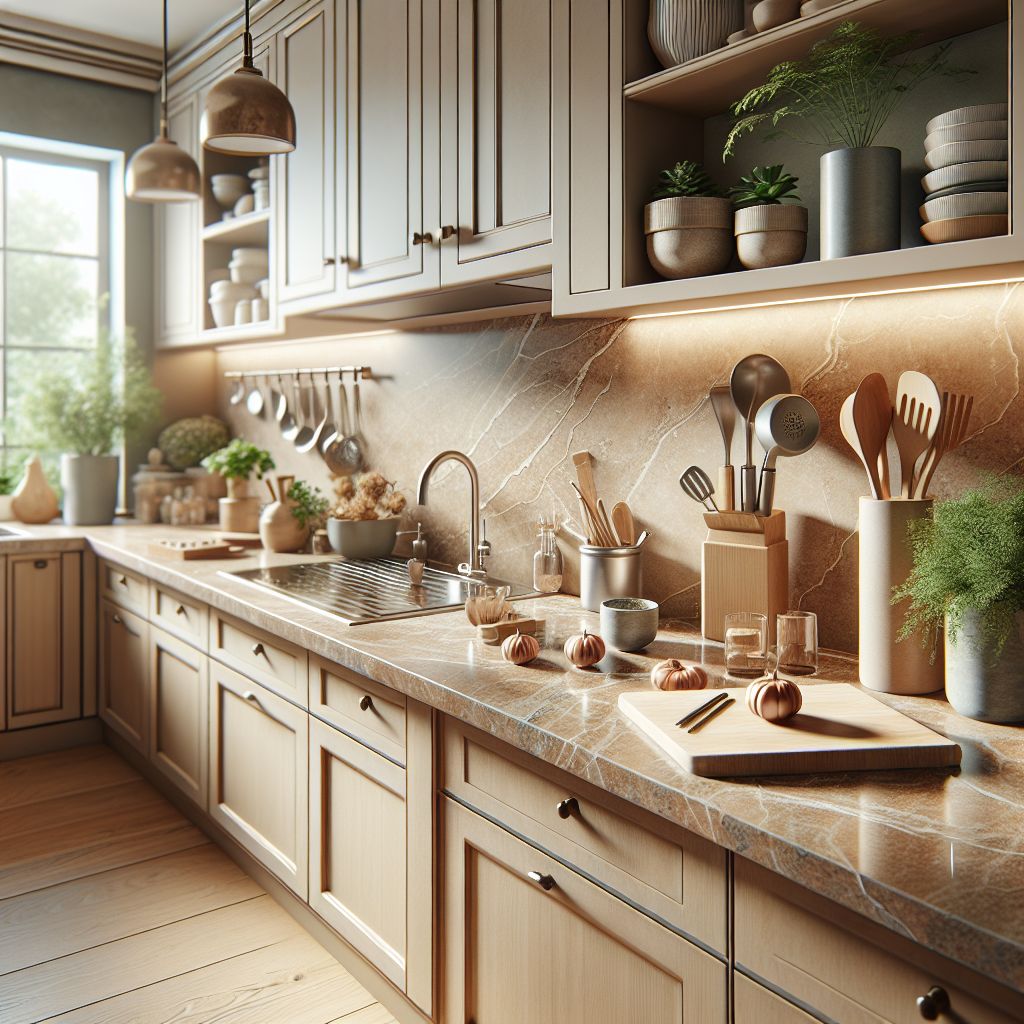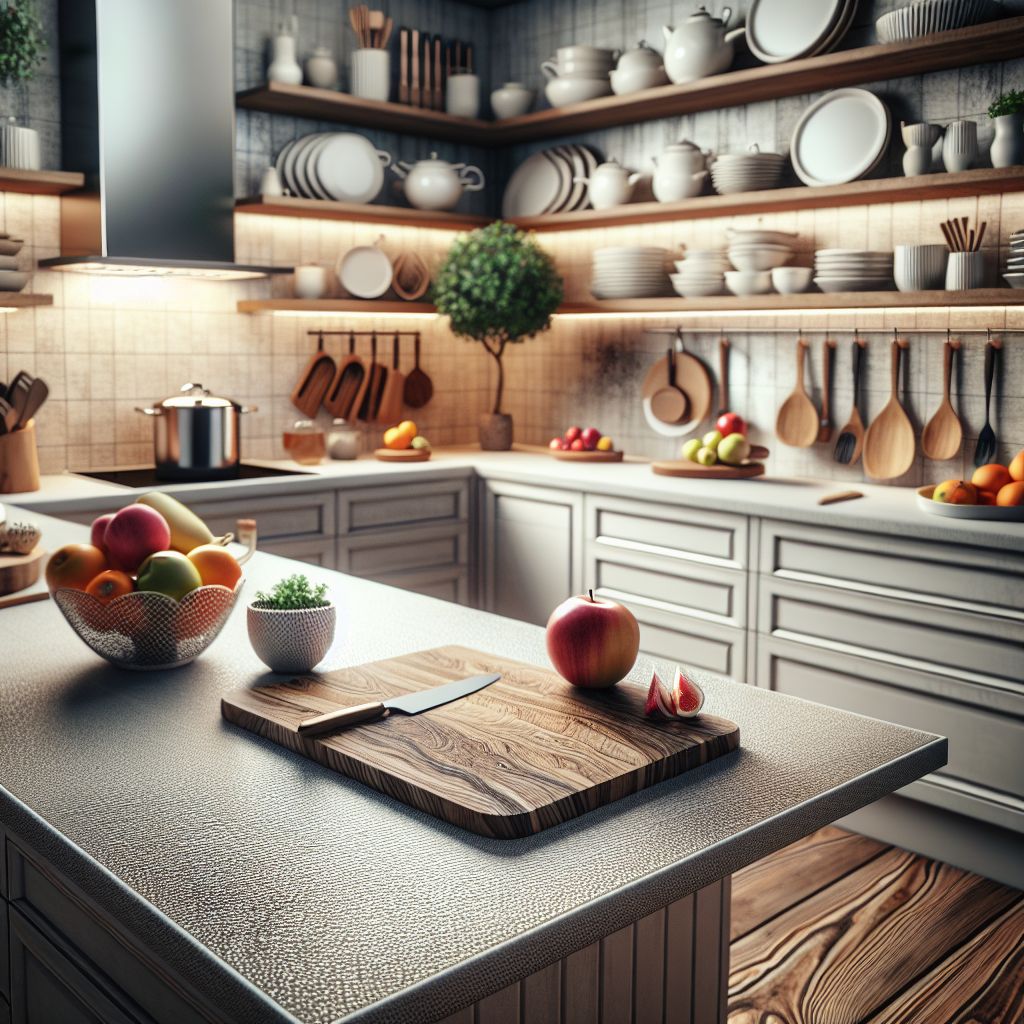
Key Takeaways: Making the Best Choice for Your Kitchen Countertops
-
Laminate countertops offer a budget-friendly and stylish option with a wide range of designs.
-
Refinishing your countertops can save money and time, transforming their look without a full remodel.
-
Remodeling, while more expensive, may be the right choice if you’re looking for a long-term investment or a complete style overhaul.
-
A detailed cost analysis will help you weigh the pros and cons of refinishing versus remodeling.
-
Understanding the condition of your current countertops and your renovation goals is crucial in making the final decision
Refinishing vs Remodeling Laminate Kitchen Countertops: Evaluating the Pros and Cons
| Refinishing | Remodeling | |
| Cost | $200 to $500 | $2,000 to $4,000 |
| Timeline | Takes a few days, can be a weekend project | Takes several weeks |
| Pros | Quick fix, low-cost, convenient | Increases home value, upgrades to a more durable surface that lasts longer, complete style overhaul |
| Cons | Less durable, deeper damages may not be fully concealed, requires more frequent touch-ups | Higher initial investment, lengthy kitchen downtime |
The Refinishing Route
If your laminate countertops are looking a bit tired but you’re not ready for a full kitchen upheaval, refinishing might just be your ticket to a fresh new look. It’s like giving your countertops a mini facelift without the invasive surgery of a complete remodel.
It’s a straightforward process that can be completed in a weekend, and the result is countertops that look brand new.
What Does Refinishing Entail?
Refinishing is all about working with what you’ve got. It involves cleaning, sanding, and applying a new finish to your existing laminate countertops. This process can hide scratches, chips, and other signs of wear, giving your countertops a refreshed appearance. And the best part? You can pick a new color or pattern that better suits your current style preferences.
Pros of Refinishing: Cost and Convenience
Why choose refinishing? First off, it’s cost-effective. You’re looking at a fraction of the cost of new countertops. Second, it’s convenient. There’s no need to rip out your old countertops and endure a lengthy kitchen downtime. You can get the job done quickly and with minimal fuss.
Cons of Refinishing: Durability and Damages
Refinishing laminate countertops has drawbacks: durability may not match the original, leading to quicker wear, and deeper damages may not be fully concealed, requiring frequent touch-ups or eventual replacement.
Step-by-Step Guide to Refinishing
Ready to dive into refinishing? Here’s a simple guide to walk you through it:
Step 1: Clear your countertops and give them a good cleaning. You want to remove any residues that could prevent the new finish from adhering properly.
Step 2: Next, grab some sandpaper and give those counters a light scuffing. This roughs up the surface and helps the primer stick.
Step 3: Once sanded, wipe down the surface to get rid of any dust. Then, apply a high-adhesion primer specifically made for laminates. This is your foundation for a durable finish.
Step 4: After the primer has dried, it’s time for paint. Choose a paint designed for laminate; these are usually acrylic or enamel based. Apply with care, following the grain of the original laminate for the best look.
Step 5: The final step is to seal your work with a clear coat that’s suitable for laminate surfaces. This will protect your newly refinished countertops from everyday kitchen activities.
And there you have it. With a little elbow grease and some patience, you can breathe new life into your kitchen without a major renovation.

Opting for Remodeling
But what if refinishing just isn’t enough? Sometimes, you’ve got to go all in and opt for a full remodel. This is the path you take when your countertops are beyond a simple facelift—think significant damage, outdated style, or a layout that just doesn’t work for you anymore. Remodeling gives you a clean slate to work with, but it’s a bigger commitment in terms of time, disruption, and, yes, money.
When Should You Remodel?
If your countertops are severely damaged, if you’re dealing with design limitations, or if you’re planning on selling your home and need to update for market appeal, remodeling is the way to go. It’s also worth considering if you’re after a complete transformation that refinishing alone can’t achieve.
Remember, a remodel isn’t just about aesthetics. It’s also an opportunity to address functional issues with your current setup. Maybe you need more counter space, or perhaps you’re dreaming of that breakfast bar. If your current countertops are standing in the way of your ideal kitchen, it’s time to remodel.
Long-Term Advantages of Remodeling
Remodeling can bring a host of long-term benefits. Not only does it provide the chance to correct any functional shortcomings of your current kitchen layout, but it also can significantly increase the value of your home. New countertops, especially if you upgrade to higher-end materials, can be a major selling point. Plus, you’ll get to enjoy a beautiful and practical kitchen for years to come.
Disadvantages of Remodeling
Remodeling laminate kitchen countertops comes with several downsides. The cost of completely replacing countertops can be considerable, especially if you opt for higher-end materials or intricate designs, making it a substantial investment. Additionally, the remodeling process can cause disruption to your kitchen’s functionality, requiring temporary arrangements for cooking and meal preparation. Overall, while remodeling can improve aesthetics, it’s important to weigh the cost and potential inconvenience against the desired outcome.
The Remodeling Process from Start to Finish
The remodeling process is a journey from conception to completion. It starts with a vision and ends with a space that’s tailored to your needs and tastes. Let’s walk through what to expect when you decide to take the plunge.
Creating a Design Plan
Your first step is to dream big. Think about how you use your kitchen and what changes would make it more functional and attractive. Sketch out your ideas or use online design tools to create a blueprint. This plan will be your guide and communication tool when you start working with professionals.
Selecting Materials and Hiring Contractors
Next, it’s time to choose your new countertops. Research materials, colors, and edge profiles. Once you’ve made your selections, reach out to contractors for quotes. Look for professionals with solid reputations and the know-how to bring your vision to life. Be sure to check references and past work to ensure they’re up to the task.
The Installation Phase
During installation, your kitchen will be out of commission, so plan accordingly. The old countertops will be removed, and the new ones fitted. This process can take anywhere from a few days to a couple of weeks, depending on the complexity of your project.

Comparing Costs and Outcomes
So, let’s talk turkey. How much will each option set you back? Refinishing your laminate countertops can cost as little as a couple hundred dollars, especially if you do it yourself. On the flip side, remodeling can run into the thousands, particularly if you opt for high-end materials like granite or quartz.
Refinishing vs Remodeling: A Cost Analysis
On average, refinishing might cost you anywhere from $200 to $500, while remodeling could be anywhere from $2,000 to $4,000 or more. But it’s not just about the upfront costs; consider the longevity and durability of the results as well.
-
Refinishing: Quick fix with low cost but may need to be redone in a few years.
-
Remodeling: Higher initial investment but adds value to your home and lasts longer.
Most importantly, weigh the disruption to your daily life. Refinishing is a short-term project with minimal kitchen downtime. Remodeling, on the other hand, could leave you without a fully functional kitchen for weeks.
When deciding between refinishing and remodeling, it’s critical to consider not just the cost but the scope and scale of your project, your long-term plans for your home, and how much inconvenience you’re willing to tolerate.
Evaluating Your Current Countertop Condition
Before you decide whether to refinish or remodel, take a good, hard look at your current countertops. Are they just dull and dated, or are they truly damaged? Minor blemishes can often be hidden with a new finish, but deep cuts, burns, or warping might mean it’s time for a replacement. Assessing the condition of your countertops is the first step in determining the right path forward.
Prioritizing Your Renovation Needs and Goals
Next, consider what you really want from your kitchen renovation. Are you looking for a quick update, a complete style change, or an improvement in functionality? If it’s simply about aesthetics, refinishing could be the answer. But if you’re looking to reconfigure your space or upgrade to a more durable surface, remodeling might be the way to go. Aligning your renovation goals with your budget and the condition of your countertops will help guide your decision.

Frequently Asked Questions (FAQs)
You’ve got questions, I’ve got answers. Let’s tackle some common queries about refinishing and remodeling laminate kitchen countertops to help you make an informed decision.
How Long Do Refinished Laminate Countertops Last?
A refinished laminate countertop can last several years if done correctly and cared for properly. On average, you can expect a refinished laminate countertop to hold up for about 5 to 7 years. Of course, this lifespan can be shorter or longer depending on the amount of wear and tear it experiences. It’s important to use cutting boards, avoid placing hot pots directly on the surface, and clean up spills promptly to extend the life of your refinished countertops.
Can You Remodel Countertops Without Replacing Cabinets?
Absolutely. If your cabinets are still in good shape, you can simply replace the countertops. This is a common approach and can save you a significant amount of money and hassle. Just ensure that the new countertops are compatible with the existing cabinet structure and that the weight and dimensions are suitable. A professional installer can help you navigate these considerations to ensure a smooth transition.
Is Refinishing Countertops a DIY-Friendly Project?
Refinishing countertops can be a DIY project, but it requires patience, attention to detail, and the right materials. If you’re comfortable with home improvement tasks and willing to follow the steps carefully, you can achieve a great result. However, if you’re unsure or want a guaranteed professional finish, it might be best to hire a specialist.
What Are the Latest Trends in Laminate Countertop Design?
Laminate countertops have come a long way in terms of design and quality. The latest trends include realistic stone and wood patterns, dramatic colors, and interesting textures. Manufacturers are also offering custom edge profiles and finishes that mimic natural materials so closely that it’s hard to tell the difference. These advances make laminate an even more attractive option for those looking to update their kitchen on a budget.
How Much Value Does a Kitchen Remodel Add to Your Home?
On average, homeowners recoup about 60% to 80% of their kitchen remodel costs when they sell their home. High-quality countertops are a significant part of that value. Whether you choose to refinish or replace your countertops, a fresh and modern kitchen can be a major selling point and may help your home stand out in the market.



